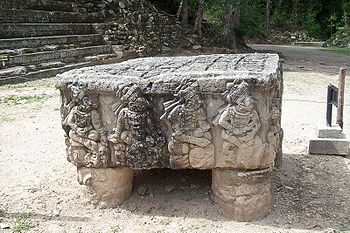- Copán Altar Q
-
Altar Q 
Altar Q at Copán.Created 776 at Copán (Honduras) Present location Copán Sculpture Museum Altar Q is the designation given to one of the most notable of the rectangular sculpted stone blocks (dubbed "altars") recovered at the Mesoamerican archaeological site of Copán, present-day Honduras.
Copán was a major Maya civilization center during the Classic period of Mesoamerican chronology, and Altar Q records a dynastic lineage for the Copán-based polity in the Maya script. It was created during the rule of King Yax Pac in 776. Each of the sixteen leaders of Copan are shown with a full body portrait, four on each side of the monument. It starts with Yax K'uk' Mo', who ruled starting in 426, and extends through 775. Therefore, the monument's depictions span three hundred and fifty years of time. Each ruler is seated on a glyph that represents his name. The most important part of the picture is Yax Kuk Mo handing down the insignia of reign to Yax Pac. This was a form of propaganda, intended to show that Yax Pac was just as worthy of rule as the first leader.
The name Altar Q was given by Alfred P. Maudslay who conducted the first archeological exploration of the site in 1886. At that time the altar was located at the bottom of the staircase in Structure 16, the central pyramid in Copán's acropolis. It has subsequently been moved to the Copán Sculpture Museum.
External links
Categories:- Mesoamerican artifacts
- Maya inscriptions
- Copán
- Mesoamerica stubs
Wikimedia Foundation. 2010.
